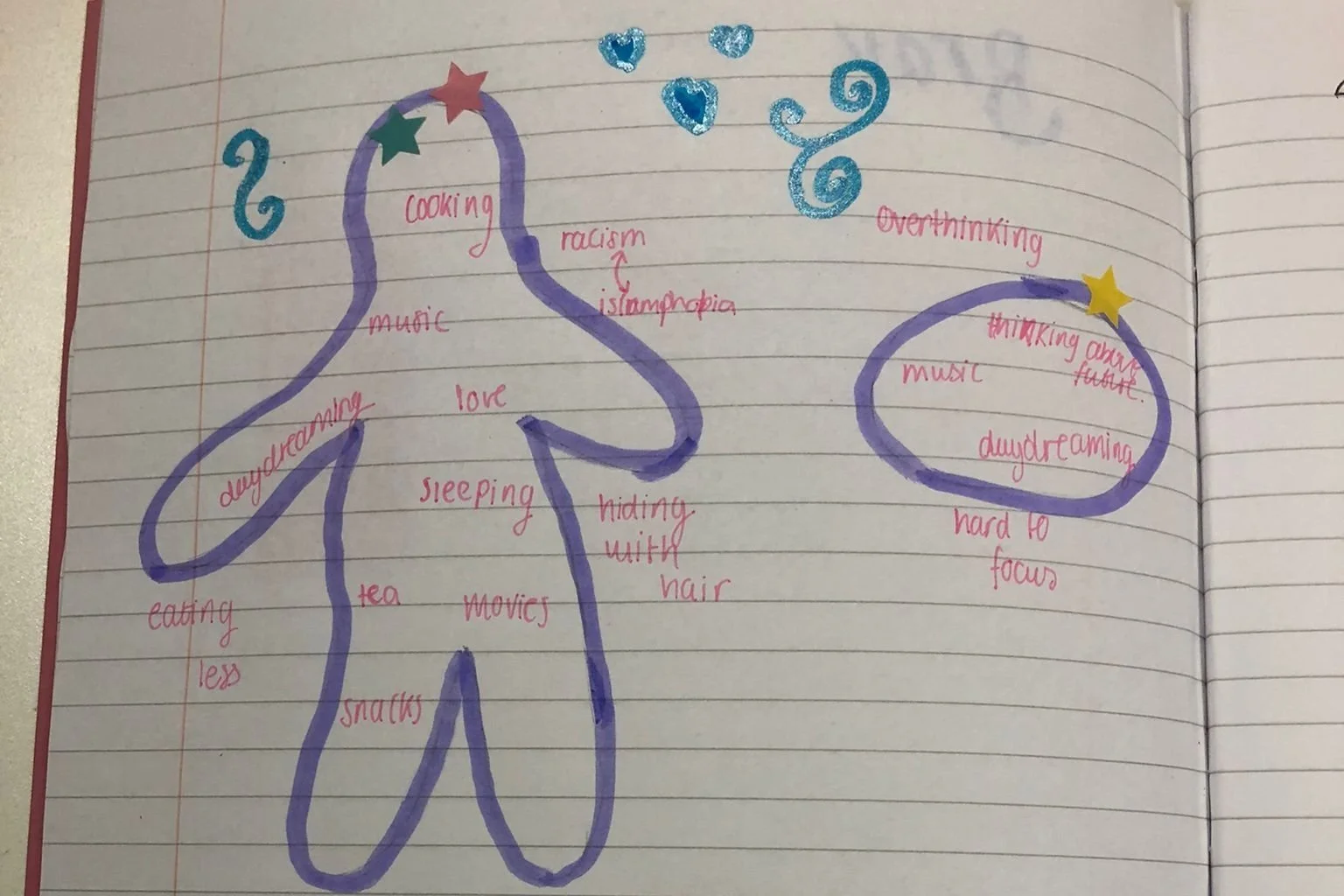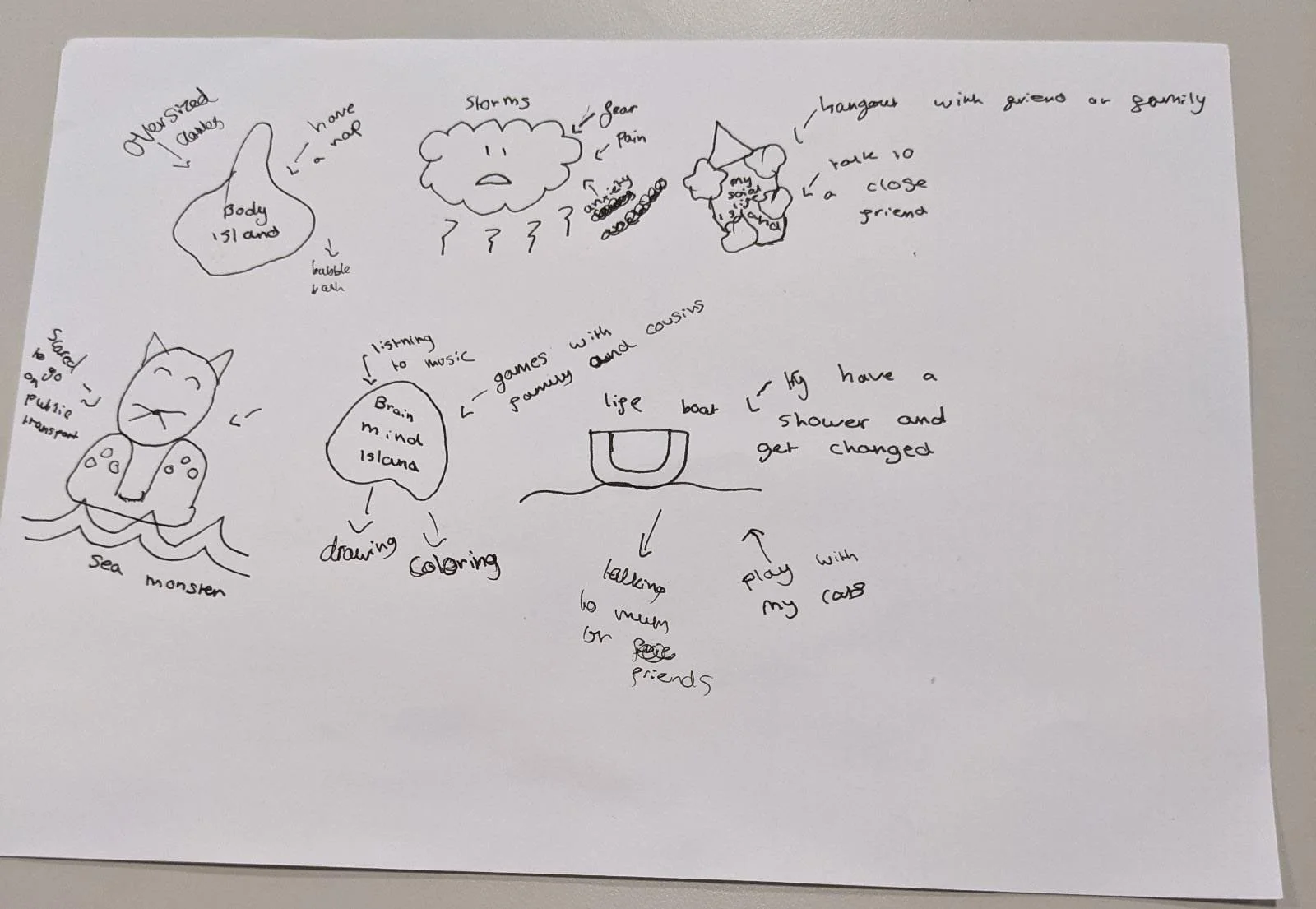workshop 5
Self-care
overview
This session is about self-care, but not in the superficial, buzz-word-y sense that it’s often used on social media. Self-care involves recognising your own needs and responding truthfully to them. The session looks at exploring compassion to yourself and then, by extension, to others you know and the wider community. You’ll plan how to practice self care independently, and do some self care together.
YOU WILL NEED
Blank paper and coloured pens / pencils.
Materials for your self care activity, e.g. nail paints, colouring materials, baking or cooking equipment
check-in
Go round the group and share one way that you care for yourself when things feel difficult.
creative activity
Begin with a blank sheet of paper for everyone, explaining that we’ll be drawing treasure maps for ourselves to help us practice self care when things feel difficult.
First, draw some islands on your map, including:
A body-shaped island representing your own body
A brain-shaped island representing your mind
An archipelago or group of body-shaped islands representing your social life / interactions with people
Some sea monsters, waves and storms around the islands representing struggles and challenges
A life boat representing emergency situations
Remind yourselves of the discussions from workshop 3 here, bringing up the particular worries and needs that the students identified and writing them in the ocean surrounding the islands they relate too. For example, pressure from work might be a storm next to the mind-shaped island, troubles with friends could be a sea monster approaching the social life archipelago, and body image insecurities might be waves around the body-shaped island.
In a different colour, write labels on the island with some self care activities that you could do to help with those challenges. These are like marking buried treasure on the map. For example, on the body-shaped island you could write ‘have a bubble bath’. On the social life island you could write ‘plan to meet up with my closest friend’. On the mind-shaped island you could write ‘listen to some calming music on a walk’.
Finally, put some emergency self care activities in your life boat, for when things feel really bad, or unbearable. This could mean things like having a cry, staying home, or seeking help from a responsible adult.
SELF-CARE ACTIVITY
Now, spend some time together chatting, listening to music, and doing a gentle self care activity together.
Select an activity that everyone in the group will feel comfortable with, or provide options. Some (but by no means an exhaustive list) of our favourites include:
nail-painting (provide clear polish, hand cream and files in case students don’t feel comfortable with coloured polish)
baking or cooking, if you have access to facilities
colouring (try these free print-outs)
watching a film together (we recommend ‘Rocks’ available on Netflix)
clay or play-dough modelling
origami (try making a self-care finger game with these exercises from our partners Femigami)
gratitude journalling - write a list of things you are grateful for
listening to a guided meditation together (Headspace offer free membership for educators)
doing an exercise video together like this kickboxing video on YouTube
DISCUSSION PROMPTS
Discuss what self-care/ self-compassion might mean or connote for them.
You could split up the compound word into its two parts and explore the connotations of each. ‘Self’ is often used as a prefix for words with negative associations like ‘selfish’ and ‘self-centred’.
Why might this be?
Is this a good thing?
How does it feel to think only of yourself?
Can you be there for others if you aren't there for yourself? Why/why not?
Explore the idea of positive selfishness; by being 'selfish' – I.e. by expressing yourself and responding to your needs, you can better care for the community around you.
You could introduce the metaphor of the oxygen mask, which we are asked to put on ourselves first when we go on flights. Self care can enable us to care for others too.
CHECK-OUT:
Go round the group, each of you making a pledge to do one self care activity this week picked from your treasure maps.
Further reading / thinking
Self-described “black, lesbian, mother, warrior, poet” Audre Lorde wrote that “Caring for myself is not self-indulgence, it is self-preservation, and that is an act of political warfare.” She wrote this in her 1988 book ‘A Burst of Light’, which was written soon after she was diagnosed with cancer for a second time.
We want this workshop to challenge the association of self-care with Instagram influencers who are mainly white, slim and able-bodied, and instead make the case for self-care as ultra-important for those whose bodies are marginalised and oppressed – especially people from Black and minoritised backgrounds, disabled people, and those from the LGBTQ community.
From a community activism perspective, self-care is really important; if we first we look after ourselves and educate ourselves, then we are able to build strong social emotional skills, thereby giving us the confidence to disrupt and challenge unfair systems.
This article makes the case for self-care as a feminist act, integral to activism. This guide to sustainable activism from Amnesty International explores self-care as a necessary part of activist work.




